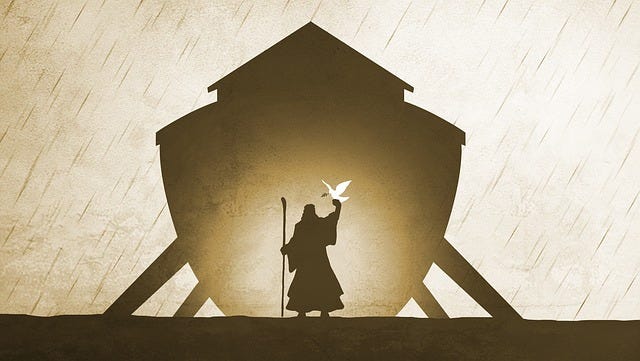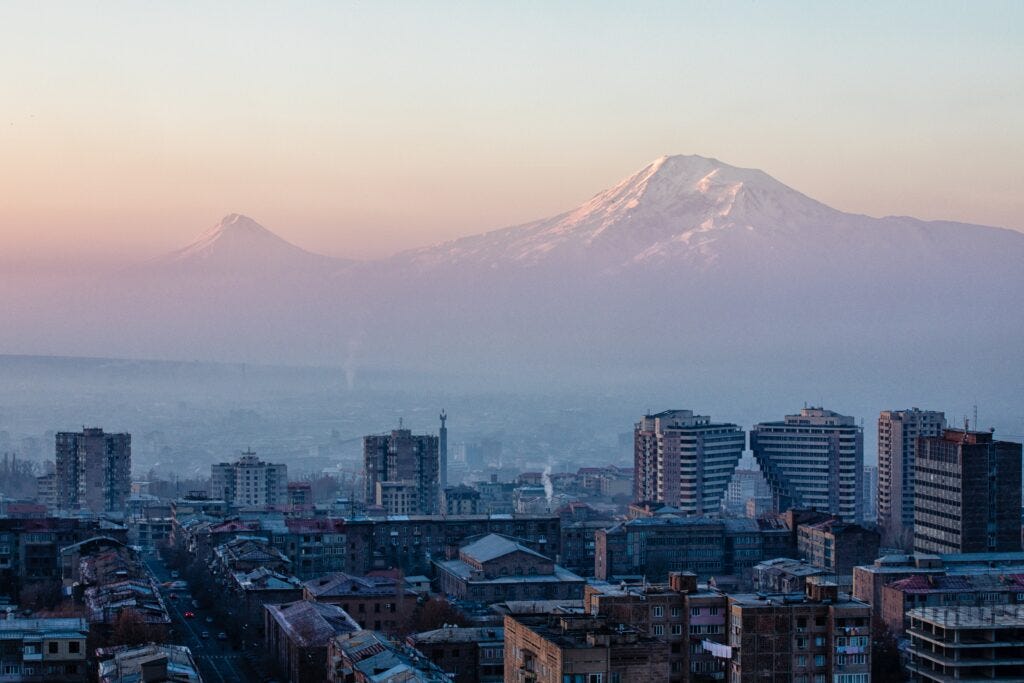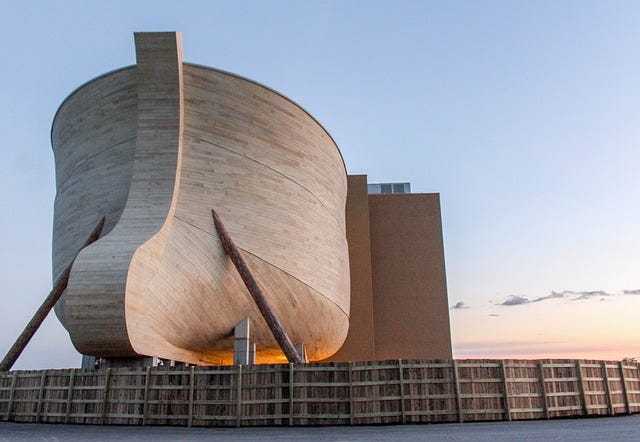Who has never heard of the Flood and Noah’s Ark? The myth is still relevant today and, in fact, some scientists are carrying out research to locate the legendary shipwreck. In Kentucky, they even constructed an impressive 100-million-dollar life-size replica of the Ark. With modern science, nothing stands in the way of those who wish to mastermind such a major undertaking.
Myths are a rich source of inspiration for literature and films. Science-fiction authors love to borrow elements from myths to create their futuristic world and plot their stories. As you can guess, I love doing just the same!
In my series Amaranth, the Ark was partly inspired by this ancient myth which is still relevant today, what with the melting glaciers and the rising sea levels. Who knows ? One day we could take shelter from a cataclysmic flood aboard those giant vessels!
I thought it would be interesting to share some of the research I gathered before writing my series in 2015. At the time, we hadn’t gone through a pandemic and had no idea of what was coming for us. I think what might have seemed impossible to me at the time can feel relatable to readers today, which is mind-boggling.
Some people who had read early drafts of my book like to joke by telling me I have an uncanny gift of foresight. Actually, science-fiction authors can hit the mark with their predictions years before major events or changes happen. Emily St. John Mandel with her book Station Eleven, now made into a TV series, is a stark example of that. Storytelling can be very powerful indeed.
What was apparent from my research about Noah’s Ark and the Flood is that it most likely happened, but perhaps not the way we imagine it.
I have recently read an amazing book by the French author Eric-Emmanuel Schmitt called Paradises Lost from his The Passage Through Time series, which is hitting shelves this week. The main character is the mythical Noah, who grows up in one of the first prehistoric villages that marks the end of the traditional nomadic lifestyle and the beginning of the civilized world. Schmitt does an excellent job at depicting what the neolithic era must have been like. The society depicted at the time gives us a glimpse at a time that feels so far away, yet whose powerful legends are still told in our day and age.
For the curious among you, I highly recommend you pick up this book after reading this post. I have broken down my research in bite-sized chunks as follows:
The origin of the myth
The power of a myth
When fiction becomes reality
A future molded by myths
The Origin of the Myth
Noah’s Ark is intrinsically tied to the Flood because it was built in response to it: a gigantic ship that can house God’s chosen ones — animals included! — to build the world anew. Historically, this well-known legend was known as the Epic of Gilgamesh, found on twelve holy tablets that date back from 1300-1600 BC. Different versions have existed through time with a cataclysmic flood at its core, but sometimes the facts were so stretched as to be nearly unrecognizable. How is this possible?
Flash floods are no stranger to us. Every year in Canada, during the thawing season, spring floods cause extensive damage to riverside towns, forcing thousands of people to evacuate and find shelter away from the shore. People have learned to fear the rising flood waters.
Tragic stories are common and spread easily among people. The most persistent of those stories are then passed down from generation to generation through oral tradition. But what makes them so relatable to those people is that they are anchored in their environment, and by extension their homeland, a place where they should be safe.
Those anecdotal stories stem from facts. But over time, the entertaining embroidery of the facts and the inaccuracies that get entangled become the stuff of legend.
The Power of a Myth
What makes the Flood and Noah’s Ark special is that they have transcended the simple myth and are considered sacred. Today, Mount Ararat, the alleged location where the shipwreck of Noah’s Ark lies, attracts thousands of tourists, many of whom are of religious faith. People are still very much interested in learning about the past and their origins, and the uncovering of ancient myths continues to tickle the minds.
In an interesting interview with Joanna Penn, Rick Antonson reports that Mount Ararat is a holy symbol of pride in the local Turkish community. To learn more about the origins of the myth and the traces it left behind up until now, you can read the fascinating interview here.
When Fiction Becomes Reality
The film industry can give a second breath to myths. The movie adaptation of Darren Aronofsky of the film Noah (released in 2014) with Russell Crowe and Emma Watson is a great example of how modern technology can revive old stories. Aronofsky reimagined the myth and enhanced it with special effects that contributed to creating a larger-than-life experience.
Other movies used the Ark in the background as in 2012 (released in 2009) from Roland Emmerich. In this adaptation, a new Flood forces humanity to seek refuge within sophisticated metal arks, an upgraded version of the wooden design we grew up seeing. The concept is in line with current tastes and gives a modern spin on a classic myth.
I remember watching the movie and wondering what would happen if people truly survived aboard those arks. What if humanity had to live aboard for an extended period of time, or perhaps until the waters of the Flood recede? Could people wait for so long without going mad?
A Future Molded by Myths
New myths will keep feeding our imagination for generations to come, and help us understand the changing world we live in. Luckily for us, science-fiction and fantasy books will continue to question what we take for granted, while helping us imagine the many futures that lie ahead.
Do you know any film adaptations or books of other myths that you enjoyed? If so, please leave a comment!
Feel free to share this post to start a conversation:
BONUS CONTENT:
Download your free digital copy of Flower of Memory, the prequel novella to the Amaranth series, a sci-fi dystopian story with a touch of fantasy, for a limited time. Ideal for fans of Hugh Howey’s Silo and The Last of Us.






